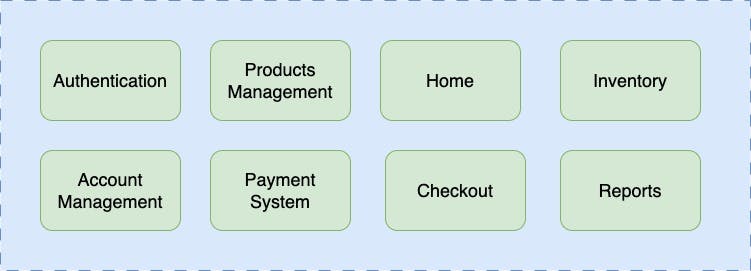By Matheus Castiglioni
There are challenges to overcome when building new applications
Building new, frontend applications presents some key challenges that must be overcome to ensure they deliver what the user expects from them. They need the flexibility to add new features, the scalability to grow the project or add new developers to it, and the intuitive capability for developers to locate and implement fixes and incorporate new elements.
We can define a few architectural characteristics (-ilities) for these requirements, for example:
Scalability
Flexibility
Modularity
Readability
Simplicity
Each characteristic matches with a requirement discussed above. For instance, scalability matches with growing the project or bringing new developers to it. Flexibility, readability and simplicity match with adding new features or bug fixes. Modularity matches with giving semantic information to developers to know where they need to go and what are the software boundaries.
Now we’re able to start designing the project and architecture style.
Check out the react-example to see a simple demo project using the following principles and ideas addressed in the post.
Using a modular architecture
For scalability, flexibility and modularity, we can use a modular architecture to define the boundaries of the subdomains in the project. By using a modular architecture we have a domain-partitioned project structure where we can see the boundaries between each subdomain.
technical partitioned
domain partitioned
Here we can bring inspirations from domain-driven design, feature-based architecture, vertical slice architecture and screaming architecture (along with a range of other styles).
Adding logical layers
Next, still focusing on flexibility, we should put some logical layers into the project — each layer will carry a single responsibility and make the code evolution simpler. In this case, we’ll define these three layers:
Application
Containers
Interfaces
Infrastructure
Shared
Application layer
In the application layer (a.k.a subdomains) will reside all logic related to the application itself. For example:
Data management
API requests
UI components
All the pages for the application
Routes of the application
Etc…
application layer
project-name
src
subdomains
products-catalog
components
// scoped components used only by products-catalog
// subdomain
product.entity.js
routes.js
services.js
store.js
...
Container layer
The container nested layer is related to dependency injection. Its responsibility is to provide concrete implementations for the abstractions and each business capability should have a single container.
project-name
src
subdomains
products-catalog
containers // injecting dependencies
list.container.js
...`
All the code examples will be written using React, as it’s the most popular frontend library as of now (you can use any other library or framework, though).
import { ApplicationLayout } from '@layouts'
import { PrivateRoute } from '@infrastructure'
import { ListInterface } from '../interfaces/list.interface'
export const ListContainer = () => {
const i18n = useI18n()
const router = useRouter()
const store = useSelector()
const features = useFeatureFlags()
const client = useGraphQLClient()
const askForData = () => {
// retrieve all data from the API
client.query()
}
const navigateTo = route => router.push(route)
return (
<PrivateRoute>
<ApplicationLayout>
<ListInterface
features={features}
messages={getMessages(i18n)}
onNavigate={navigateTo}
products={store.products.collection}
/>
</ApplicationLayout>
</PrivateRoute>
)
}
Interface layer
The interface nested layer is related to defining the markup and the UI for the application pages — it’s where all the HTML (JSX/TSX) code goes. Each page needs to have a single container attached to it, as it’s a one-to-one relationship.
project-name
src
subdomains
products-catalog
interfaces // markup for all pages
list.interface.js
...
export const ListInterface = ({
features,
messages,
onNavigate,
products,
}) => {
const hasShoppingCart = features.includes(SHOPPING_CART')
return (
<>
<h1>{messages.title}</h1>
<Each collection={products}>
{(product) => (
<Card onClick={() => onNavigate(product.id)}>
<Card.Title>{product.title}</Card.Title>
<When condition={hasShoppingCart}>
<Card.Action
on={() => ...}
>
{messages.addToCart}
</Card.Action>
</When>
</Card>
)}
</Each>
</>
)
}
Pay attention to the products-catalog/routes.js file, you have to import and attach only containers for the routes.
import { ListContainer } from './containers/list.container'
export const routes = {
List: ListContainer,
}
Infrastructure layer
In the infrastructure layer, we’ll include all the necessary details on how abstractions should work and perform their actions. For example, handling API requests (using REST or GraphQL), store management, application theme logic, navigation handling and other things.
project-name
src
shared
modules
infrastructure
fetch-data-provider.infrastructure.js
...
import { createClient, Provider } from 'urql'
export const FetchDataProvider = ({ children }) => {
return (
<Provider value={createClient()}>
{children}
</Provider>
)
}
Shared layer
Finally, the shared layer will contain elements that are used across the entire application, usually global abstractions such as UI/business components, utils, global types and interfaces, helpers, translations, enums, layouts, and more.
project-name
src
shared
modules
components
business // smart components with business logic
price.component.js
ui // dumb components only with interface logic
button.component.js
infrastructure
fetch-data-provider.infrastructure.js
state-provider.infrastructure.js
theme-provider.infrastructure.js
layouts
admin.layout.js
application.layout.js
utils
number.util.js
text.util.js
We should create ADR (Architecture Decision Record) document files to specify the reason for each definition, but this is a topic for another blog post — in the meantime, if you want information on creating ADR document files, I recommend you read this article. Below we can see a landscape of all these requirements being resolved by each characteristic.
project-name
src
subdomains
product-catalog
containers
list.container.js
interfaces
list.interface.js
product.entity.js
routes.js
services.js
store.js
shared
modules
components
business
price.component.js
ui
button.component.js
infrastructure
fetch-data-provider.infrastructure.js
state-provider.infrastructure.js
theme-provider.infrastructure.js
layouts
admin.layout.js
application.layout.js
utils
number.util.js
text.util.js
Although the code examples were written using React, this architecture style is technology agnostic — by this I mean, libraries and frameworks. The style can be used by React, Angular, Vue, Svelte, Next, Nuxt, Gatsby, SvelteKit, Angular Universal, etc…
Conclusion
There’s no silver bullet to resolve all the problems and challenges we face when we’re building and shipping software. Instead, we need to focus on decreasing the complexity to better handle problems like the ones I’ve covered in this blog post.
By making the project semantic, using a nice folder structure with a separation of responsibilities, incorporating well-defined context boundaries, applying modularization and adding logic layers to handle different concerns we’re able to scale any software project.




